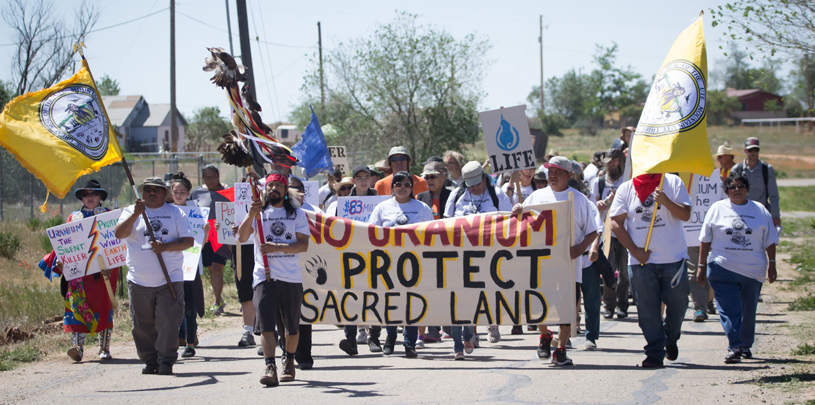
 by Anne Mariah Tapp, Law and Policy Advisor
by Anne Mariah Tapp, Law and Policy Advisor
Last month, over a hundred people gathered to walk to the White Mesa uranium mill, taking a stand against uranium contamination. The protest walk was organized and led by White Mesa Concerned Community, a grassroots group based in White Mesa, Utah, whose leaders — all members of the Ute Mountain Ute Tribe — have been fighting against the nearby White Mesa Mill for over a decade.
White Mesa Concerned Community was joined by Ute Mountain Ute tribal members from reservations in White Mesa, Utah and Towaoc, Colorado, concerned citizens of the nearby Navajo Nation who are directly impacted by the hauling of uranium to the White Mesa Mill, neighbors from Moab, Bluff, and Salt Lake City, and supporters from as far away as Australia — all working in solidarity to protect communities from uranium contamination.
The walk came as the state of Utah considers three key licensing decisions to allow the White Mesa uranium mill to continue operating:
The state of Utah is accepting comments from the public until July 31, 2017. A public hearing is scheduled for June 8 in Salt Lake City, and a public meeting for June 15 in Blanding, Utah.
The story of uranium on the Colorado Plateau is a story of injustice. From east to west and north to south, the Colorado Plateau’s communities, red mesas, slot canyons, dense forests, and hardworking rivers and streams bear the impact of this toxic industry. And too often, just as with the White Mesa Mill, the communities most impacted have been those of Native American tribal members, left with cancer clusters, devastated lands, and poisoned waters.
This is not a story buried in the past; it is a story being written today in Utah’s red rock country and one that is memorializing its legacy in the groundwater that feeds the Grand Canyon’s seeps and springs. It is a modern-day story whose every twist and turn leads you back to the White Mesa uranium mill, the processing site for every ton of uranium ore mined on the Colorado Plateau. The only conventional uranium mill still operating in the United States, it’s located three miles from the Ute Mountain Ute tribal community of White Mesa, Utah.
It’s important that regulators hear from you. We’ve been working with partners and supporters to put White Mesa on the map, both literally and metaphorically, through legal action and organizing, and this public comment period is a rare opportunity to make your voice heard.
*Audience members will have a chance to comment publicly and pose questions to regulators.
Stay tuned in the coming weeks for more information about specific concerns you might consider including in your comments.
The Colorado Plateau and its communities have borne the impacts of the uranium industry for too long. Now is the time to stand up for White Mesa and to protect the communities, land, water, wildlife, and clean air of the Colorado Plateau from toxic uranium contamination.
More than 275,000 pounds of radioactive materials imported from the Japan Atomic Energy Agency headed to Utah's White Mesa Mill.
Read MoreWhite Mesa Ute community leaders testify in Washington D.C. about how Utah's White Mesa uranium mill, near Bears Ears, affects their lives.
Read More"We want to have healthy lives. We want to have access to clean water," says Chairman Manuel Heart.
Read More